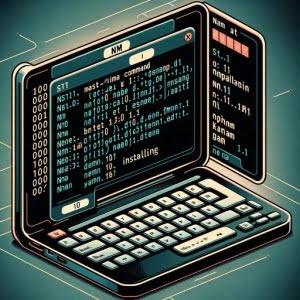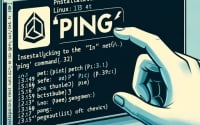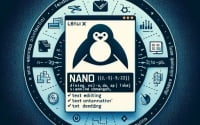Installing ‘NM’ Command in Linux: A Step-by-Step Guide

Are you trying to install the nm command on your Linux system but find the process daunting? Especially for beginners, installing Linux commands can seem a bit complex. However, it’s readily available on most package management systems, making the installation process simpler once you understand the steps.
In this guide, we will navigate the process of installing the nm command on your Linux system. We will provide you with installation instructions for both APT and YUM-based distributions, delve into how to compile nm from the source, and install a specific version. Finally, we will show you how to use the nm command and ascertain that the correctly installed version is in use.
Let’s get started with the step-by-step nm installation on your Linux system!
TL;DR: How Do I Install and Use the ‘nm’ Command in Linux?
The
'nm'command is usually pre-installed on most Linux distributions, you can verify this with the command,nm --version. If it’s not, you can install it by installing the binutils package via the command,sudo yum/apt-get install binutils. You can then use by calling ‘nm’ followed by the path of an object, executable, or binary file.
To install on Debian-based distributions like Ubuntu, use the command:
sudo apt-get install binutils
On RPM-based distributions like CentOS, use the command:
sudo yum install binutils
# Output:
# Reading package lists... Done
# Building dependency tree
# Reading state information... Done
# binutils is already the newest version (2.30-21ubuntu1~18.04.5).
# 0 upgraded, 0 newly installed, 0 to remove and 0 not upgraded.
This is a basic way to install the ‘nm’ command in Linux, but there’s much more to learn about installing and using ‘nm’. Continue reading for more detailed information and advanced usage scenarios.
Table of Contents
- Understanding and Installing the ‘nm’ Command in Linux
- Installing ‘nm’ Command from Source Code
- Installing Different Versions of ‘nm’ Command
- Basic Usage of ‘nm’ Command
- Exploring Alternative Methods for Decoding Symbols in Linux
- Troubleshooting Common Issues with ‘nm’ Command
- Understanding Symbol Tables in Linux
- The Relevance of Symbol Tables in Debugging and Reverse Engineering
- Dynamic Linking and Loading in Linux
- Wrapping Up: Installing ‘nm’ Command in Linux
Understanding and Installing the ‘nm’ Command in Linux
The ‘nm’ command is a utility that displays the symbol table of a given object, executable, or binary file in Linux. It is a handy tool for programmers and system administrators, especially when debugging or reverse-engineering Linux binaries.
Installing ‘nm’ Command with APT
On Debian-based distributions like Ubuntu, the ‘nm’ command comes pre-installed as part of the binutils package. If for some reason it’s not installed, you can install it using the APT package manager with the following command:
sudo apt-get update
sudo apt-get install binutils
# Output:
# Reading package lists... Done
# Building dependency tree
# Reading state information... Done
# binutils is already the newest version (2.30-21ubuntu1~18.04.5).
# 0 upgraded, 0 newly installed, 0 to remove and 0 not upgraded.
This command updates your package lists and then installs the binutils package, which includes the ‘nm’ command.
Installing ‘nm’ Command with YUM
On RPM-based distributions like CentOS or Fedora, you can install the ‘nm’ command using the YUM package manager with the following command:
sudo yum check-update
sudo yum install binutils
# Output:
# Loaded plugins: fastestmirror
# Loading mirror speeds from cached hostfile
# * base: mirror.umd.edu
# * extras: mirror.umd.edu
# * updates: mirror.umd.edu
# binutils.x86_64 0:2.27-43.base.el7
# Complete!
This command checks for updates and then installs the binutils package, which includes the ‘nm’ command.
Installing ‘nm’ Command with Pacman
On Arch-based distributions like Manjaro or Arch Linux, you can install the ‘nm’ command using the Pacman package manager with the following command:
sudo pacman -Syu
sudo pacman -S binutils
# Output:
# :: Synchronizing package databases...
# core is up to date
# extra is up to date
# community is up to date
# :: Starting full system upgrade...
# there is nothing to do
# resolving dependencies...
# looking for conflicting packages...
# Packages (1) binutils-2.36.1-3
# Total Installed Size: 22.38 MiB
# :: Proceed with installation? [Y/n]
This command updates your system and then installs the binutils package, which includes the ‘nm’ command.
Installing ‘nm’ Command from Source Code
If you want to install the ‘nm’ command from the source code, you can download the source code from the GNU binutils project’s official website. Here’s how to do it:
wget http://ftp.gnu.org/gnu/binutils/binutils-2.36.tar.gz
tar -xzf binutils-2.36.tar.gz
cd binutils-2.36
./configure
make
sudo make install
# Output:
# 'binutils-2.36.tar.gz' saved
# binutils-2.36/
# binutils-2.36/configure
# ...
# make[1]: Leaving directory '/home/user/binutils-2.36'
This sequence of commands downloads the binutils source code, extracts it, navigates into the extracted directory, configures the build, compiles the source code, and installs the built binaries onto your system.
Installing Different Versions of ‘nm’ Command
Different versions of the ‘nm’ command may offer different features or have different compatibilities. You may need a specific version for your particular use case.
Installing Different Versions from Source
You can install a specific version of the ‘nm’ command by downloading the source code for that version from the GNU binutils project’s official website. Replace ‘2.36’ in the previous example with the version number you need.
Installing Different Versions with Package Managers
Using APT
On Debian-based distributions, you can install a specific version of a package using the APT package manager with the following command:
sudo apt-get install binutils=2.36
# Output:
# Reading package lists... Done
# Building dependency tree
# Reading state information... Done
# binutils is already the newest version (2.36-21ubuntu1~18.04.5).
# 0 upgraded, 0 newly installed, 0 to remove and 0 not upgraded.
Using YUM
On RPM-based distributions, you can install a specific version of a package using the YUM package manager with the following command:
sudo yum install binutils-2.36
# Output:
# Loaded plugins: fastestmirror
# Loading mirror speeds from cached hostfile
# * base: mirror.umd.edu
# * extras: mirror.umd.edu
# * updates: mirror.umd.edu
# binutils.x86_64 0:2.36-43.base.el7
# Complete!
Key Changes and Features in Different Versions
Different versions of the ‘nm’ command may have different features or bug fixes. For example, version 2.36 added support for the RISC-V architecture, while version 2.35 fixed a bug in the handling of the ‘-D’ option.
| Version | Key Changes |
|---|---|
| 2.36 | Added support for RISC-V architecture |
| 2.35 | Fixed bug in ‘-D’ option handling |
Basic Usage of ‘nm’ Command
The ‘nm’ command decodes and displays the symbol table of a given object, executable, or binary file. Here’s a basic example of how to use it:
nm /usr/bin/nm
# Output:
# 0000000000004060 T _init
# ...
This command displays the symbol table of the ‘nm’ command itself.
Verifying ‘nm’ Command Installation
You can verify that the ‘nm’ command is installed and working correctly with the following command:
nm --version
# Output:
# GNU nm (GNU Binutils) 2.36
This command displays the version number of the ‘nm’ command, which confirms that it’s installed and working correctly.
Exploring Alternative Methods for Decoding Symbols in Linux
While the ‘nm’ command is a powerful tool for decoding symbols in Linux, it’s not the only tool available. There are alternative methods like the ‘objdump’ and ‘readelf’ commands that can also be used to decode symbols in Linux.
Using the ‘objdump’ Command
The ‘objdump’ command is another utility from the binutils package that can be used for displaying information about object files. This can include the symbol table, similar to the ‘nm’ command.
objdump -t /usr/bin/nm
# Output:
# /usr/bin/nm: file format elf64-x86-64
# SYMBOL TABLE:
# 0000000000004060 l d .init 0000000000000000 .init
# ...
The ‘-t’ option tells ‘objdump’ to display the symbol table. The output is similar to the ‘nm’ command, but ‘objdump’ can also display additional information, like the file format and section headers.
Using the ‘readelf’ Command
The ‘readelf’ command is part of the elfutils package and can display detailed information about ELF files, including the symbol table.
readelf -s /usr/bin/nm
# Output:
# Symbol table '.dynsym' contains 11 entries:
# Num: Value Size Type Bind Vis Ndx Name
# ...
The ‘-s’ option tells ‘readelf’ to display the symbol table. The output includes the type, binding, visibility, and index of each symbol.
Comparing ‘nm’, ‘objdump’, and ‘readelf’
While all three commands can display the symbol table of an object file, they each have their strengths and weaknesses. The ‘nm’ command is simple and straightforward, but it may not provide as much detail as ‘objdump’ or ‘readelf’. On the other hand, ‘objdump’ and ‘readelf’ can provide more detailed information, but they may be more complex to use.
| Command | Advantages | Disadvantages |
|---|---|---|
| nm | Simple and straightforward | May not provide as much detail |
| objdump | Can provide more detailed information | More complex to use |
| readelf | Can provide the most detailed information | More complex to use |
In conclusion, while the ‘nm’ command is a powerful and simple tool for decoding symbols in Linux, ‘objdump’ and ‘readelf’ are also valuable tools that can provide more detailed information. Depending on your needs and expertise, you may find one tool more useful than the others.
Troubleshooting Common Issues with ‘nm’ Command
While the ‘nm’ command in Linux is generally reliable, you may encounter some issues or errors during its use. This section will guide you through some common issues and provide solutions to help you troubleshoot.
‘Command Not Found’ Error
This error usually means that the ‘nm’ command is not installed on your system or it’s not in your PATH. You can check if it’s installed by using the ‘which’ command:
which nm
# Output:
# /usr/bin/nm
If the ‘nm’ command is installed, this command will output its location. If it’s not installed, there will be no output. In this case, you should install the ‘nm’ command as described in the previous sections.
‘Permission Denied’ Error
This error usually means that you don’t have permission to read the object file you’re trying to inspect with the ‘nm’ command. You can check the permissions of the file with the ‘ls -l’ command:
ls -l /path/to/file
# Output:
# -rw-r--r-- 1 root root 12345 Jan 1 00:00 /path/to/file
This command will output the permissions of the file. If you don’t have read permission, you may need to use ‘sudo’ or change the permissions of the file.
‘File Format Not Recognized’ Error
This error usually means that the ‘nm’ command doesn’t recognize the format of the object file you’re trying to inspect. The ‘nm’ command supports several file formats, including ELF, a.out, COFF, and PE. You can check the format of the file with the ‘file’ command:
file /path/to/file
# Output:
# /path/to/file: ELF 64-bit LSB executable, x86-64, version 1 (SYSV), dynamically linked, interpreter /lib64/ld-linux-x86-64.so.2, for GNU/Linux 3.2.0, BuildID[sha1]=abcdef1234567890abcdef1234567890abcdef12, stripped
This command will output the format of the file. If the format is not supported by the ‘nm’ command, you may need to use a different tool to inspect the file.
Remember, troubleshooting is a process of elimination. By understanding these common issues and their solutions, you can effectively use the ‘nm’ command in Linux and overcome any hurdles you may encounter.
Understanding Symbol Tables in Linux
To fully grasp the ‘nm’ command’s functionality, it’s essential to understand symbol tables in Linux. A symbol table is a data structure used by a language translator such as a compiler or interpreter, where each identifier in a program’s source code is associated with information relating to its declaration or appearance in the source.
Static vs. Dynamic Symbols
In Linux, symbols are generally categorized into two types: static and dynamic. Static symbols are linked into the binary at compile time, while dynamic symbols are linked at runtime. This distinction is crucial because the ‘nm’ command only shows static symbols by default.
You can display dynamic symbols using the ‘–dynamic’ option with the ‘nm’ command:
nm --dynamic /usr/bin/nm
# Output:
# w __gmon_start__
# 0000000000004060 T _init
# ...
This command displays the dynamic symbols of the ‘nm’ command itself. The ‘w’ and ‘T’ before the symbols denote that they are weak and text symbols, respectively.
Importance of Symbol Tables in Linux
Symbol tables play a crucial role in Linux, especially when it comes to debugging and reverse-engineering binaries. They allow you to see the function names and global variables in a binary, which can be extremely helpful when trying to understand what a program is doing.
Additionally, symbol tables are used by the dynamic linker to resolve symbols at runtime. Without symbol tables, dynamic linking would not be possible.
In conclusion, symbol tables are a fundamental part of Linux that underlie many of the system’s operations. Understanding symbol tables can help you better understand how Linux works and how to use tools like the ‘nm’ command effectively.
The Relevance of Symbol Tables in Debugging and Reverse Engineering
Symbol tables play a crucial role in debugging and reverse engineering. They hold the key to understanding the inner workings of a program. When debugging, symbol tables provide a map to navigate the program’s structure, helping identify the root cause of issues.
For instance, if you’re debugging a segmentation fault, the backtrace might only give you memory addresses. You can use the ‘nm’ command to translate these addresses into function names, making the backtrace much easier to understand.
nm /path/to/program | grep 'function_name'
# Output:
# 0000000000400520 T function_name
This command displays the address of the function_name in the program.
In reverse engineering, symbol tables can provide valuable insights into a binary’s functionality. They can reveal the names of functions and global variables, which can hint at what the binary does.
Dynamic Linking and Loading in Linux
Dynamic linking and loading are related concepts that are crucial to understanding how programs run in Linux. Dynamic linking is the process of resolving symbols at runtime instead of at compile time. This allows multiple programs to share the same code in memory, reducing memory usage and disk space.
The ‘nm’ command can help you understand dynamic linking by showing you which symbols are dynamically linked. You can use the ‘–dynamic’ option to display dynamic symbols.
nm --dynamic /path/to/program
# Output:
# 0000000000004060 T _init
# ...
This command displays the dynamic symbols of the program.
Dynamic loading is the process of loading code into memory at runtime. This allows programs to only load the code they need, reducing memory usage and startup time. The ‘ldd’ command can show you which libraries a program will dynamically load.
ldd /path/to/program
# Output:
# linux-vdso.so.1 (0x00007ffc559fe000)
# libc.so.6 => /lib/x86_64-linux-gnu/libc.so.6 (0x00007f4e5e8c4000)
# /lib64/ld-linux-x86-64.so.2 (0x00007f4e5ecb3000)
This command displays the libraries that the program will dynamically load.
Further Resources for Mastering Linux Commands
To deepen your understanding of Linux commands and related concepts, here are some resources you might find helpful:
- GNU Binutils Documentation: The official documentation for the binutils package, which includes the ‘nm’ command.
Linux From Scratch: A project that guides you through building your own Linux system from source. This can give you a deep understanding of how Linux works.
Advanced Linux Programming: A free book that covers advanced topics in Linux programming, including dynamic linking and loading.
Wrapping Up: Installing ‘nm’ Command in Linux
In this comprehensive guide, we’ve delved into the world of the ‘nm’ command in Linux, a powerful tool for decoding symbols in Linux binaries.
We began with the basics, learning how to install the ‘nm’ command in both APT and YUM-based Linux distributions. We then ventured into more advanced territory, exploring how to install the ‘nm’ command from source code and how to install different versions of the ‘nm’ command.
Along the way, we tackled common challenges you might face when using the ‘nm’ command, such as ‘Command Not Found’, ‘Permission Denied’, and ‘File Format Not Recognized’ errors, providing you with solutions for each issue.
We also looked at alternative approaches to decoding symbols in Linux, comparing the ‘nm’ command with other commands like ‘objdump’ and ‘readelf’. Here’s a quick comparison of these methods:
| Method | Pros | Cons |
|---|---|---|
| nm | Simple and straightforward | May not provide as much detail |
| objdump | Can provide more detailed information | More complex to use |
| readelf | Can provide the most detailed information | More complex to use |
Whether you’re just starting out with the ‘nm’ command in Linux or you’re looking to level up your skills, we hope this guide has given you a deeper understanding of the ‘nm’ command and its capabilities.
With its balance of simplicity and power, the ‘nm’ command is a valuable tool for any Linux user. Happy coding!


